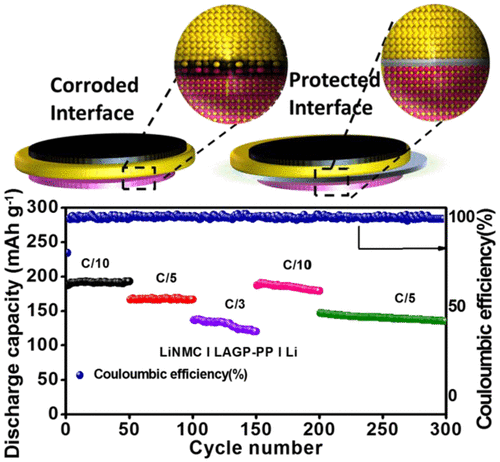当前位置:
X-MOL 学术
›
ACS Appl. Energy Mater.
›
论文详情
Our official English website, www.x-mol.net, welcomes your feedback! (Note: you will need to create a separate account there.)
LAGP|Li Interface Modification through a Wetted Polypropylene Interlayer for Solid State Li-Ion and Li–S batteries
ACS Applied Energy Materials ( IF 6.4 ) Pub Date : 2019-05-10 00:00:00 , DOI: 10.1021/acsaem.9b00301 Dasari Bosubabu 1, 2 , Jeevanantham Sivaraj 1 , Ramakumar Sampathkumar 1 , Kannadka Ramesha 1, 2
ACS Applied Energy Materials ( IF 6.4 ) Pub Date : 2019-05-10 00:00:00 , DOI: 10.1021/acsaem.9b00301 Dasari Bosubabu 1, 2 , Jeevanantham Sivaraj 1 , Ramakumar Sampathkumar 1 , Kannadka Ramesha 1, 2
Affiliation

|
The development of solid state batteries is constrained by imperative factors like the high reactivity of lithium with solid electrolytes, high grain boundary resistance of the solid electrolyte, and interfacial resistance between the solid electrolyte and electrodes. In the present work we exploited Li1.5Al0.5Ge1.5(PO4)3 (LAGP) as a solid electrolyte and noticed a spontaneous reactivity of lithium with LAGP. Further, we observed that introduction of a wetted polypropylene (PP) layer between LAGP and lithium successfully prevented the undesirable reaction between lithium and the surface of the solid electrolyte. Aside from that, it also considerably decreased the interfacial resistance and polarization. This strategy has been applied to both Li-ion and Li–S battery systems, and we observed considerable improvement in the electrochemical performance of these solid state devices. The lithium ion battery retained 100% capacity and Coulombic efficiency after 50 cycles with an observed capacity of 190 mAhg–1. After 200 cycles with varying C-rates, 98.5% capacity retention is observed. Similarly, in the Li–S battery, LAGP effectively restricted the polysulfide shuttle and maintained 78% of the initial capacity after 200 cycles. Such high capacity retention is the outcome of the PP layer which functions as an interlayer that protects the LAGP surface against reacting with the lithium metal anode as inferred by post-mortem analysis.
中文翻译:

通过固态聚丙烯离子和Li–S电池的湿聚丙烯中间层进行LAGP | Li界面改性
固态电池的发展受到诸如锂与固态电解质的高反应性,固态电解质的高晶界电阻以及固态电解质与电极之间的界面电阻之类的命令性因素的约束。在目前的工作中,我们利用了Li 1.5 Al 0.5 Ge 1.5(PO 4)3(LAGP)作为固体电解质,并注意到锂与LAGP的自发反应性。此外,我们观察到在LAGP和锂之间引入湿聚丙烯(PP)层可成功防止锂与固体电解质表面之间发生不良反应。除此之外,它还大大降低了界面电阻和极化。此策略已应用于锂离子电池和Li–S电池系统,并且我们观察到这些固态设备的电化学性能有了显着改善。锂离子电池经过50次循环后仍保持100%的容量和库仑效率,观察到的容量为190 mAhg –1。在以不同的C速率循环200次之后,观察到98.5%的容量保持率。同样,在Li-S电池中,LAGP有效地限制了多硫化物穿梭,并在200次循环后保持了初始容量的78%。如此高的容量保持率是PP层的结果,该PP层用作中间层,可保护LAGP表面免于与事后分析所推断的与锂金属阳极发生反应。
更新日期:2019-05-10
中文翻译:

通过固态聚丙烯离子和Li–S电池的湿聚丙烯中间层进行LAGP | Li界面改性
固态电池的发展受到诸如锂与固态电解质的高反应性,固态电解质的高晶界电阻以及固态电解质与电极之间的界面电阻之类的命令性因素的约束。在目前的工作中,我们利用了Li 1.5 Al 0.5 Ge 1.5(PO 4)3(LAGP)作为固体电解质,并注意到锂与LAGP的自发反应性。此外,我们观察到在LAGP和锂之间引入湿聚丙烯(PP)层可成功防止锂与固体电解质表面之间发生不良反应。除此之外,它还大大降低了界面电阻和极化。此策略已应用于锂离子电池和Li–S电池系统,并且我们观察到这些固态设备的电化学性能有了显着改善。锂离子电池经过50次循环后仍保持100%的容量和库仑效率,观察到的容量为190 mAhg –1。在以不同的C速率循环200次之后,观察到98.5%的容量保持率。同样,在Li-S电池中,LAGP有效地限制了多硫化物穿梭,并在200次循环后保持了初始容量的78%。如此高的容量保持率是PP层的结果,该PP层用作中间层,可保护LAGP表面免于与事后分析所推断的与锂金属阳极发生反应。



























 京公网安备 11010802027423号
京公网安备 11010802027423号